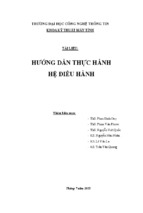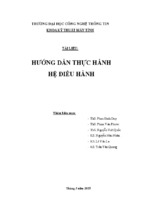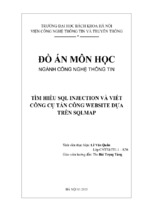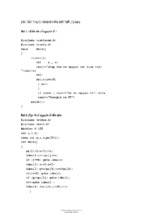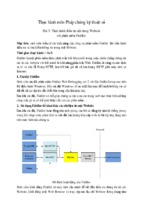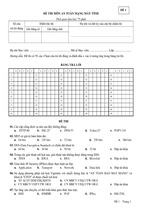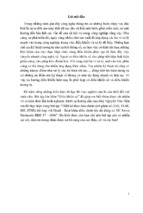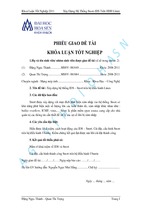Mô tả:
ISDN
Chapter 1
Integrated Service Digital Network
(ISDN)
Korea-Vietnam Friendship IT College
ISDN
Overview
•
•
•
•
•
•
•
ISDN Introduction
ISDN Technical Fundamentals
ISDN Channels
ISDN Transmission
ISDN Frames
ISDN Protocol Architecture
Khảo sát các ứng dụng hiện nay của ISDN tại Việt Nam
và thế giới
• Ưu nhược điểm so với các công nghệ khác
2
Korea-Vietnam Friendship IT College
ISDN
ISDN Introduction
• Integration
– Before WWII, integration of telegraph/telex and voice
– More recently, integration of fax and voice
– ISDN: integrate digital voice, 64-Kbps data, telex, fax,
slow-scan video
– Broadband ISDN: all of above plus video,
multimedia,…
3
Korea-Vietnam Friendship IT College
ISDN
ISDN Introduction
• Channels
– Analog public switched telecommunication network
(PSTN) based on the 4-kHz voice channel
– Present digital network based on PCM 64-Kbps voice
channel
– In-channel signaling and framing corrupted the 64Kbps channel, so integration of data required a dropback to 56-Kbps
– ISDN: local interface to a “digital pipe” enables higher
data rates
4
Korea-Vietnam Friendship IT College
ISDN
Principles of ISDN (1)
• Support of voice and non-voice applications in the same
network
– Interfaces and data transmission facilities standadized
by ITU-T
• Switched and Non-Switched connections
– Packet & circuit switching, leased lines
• 64-Kbps channel
– Chosen because at the time was the standard rate for
digitized voice
5
Korea-Vietnam Friendship IT College
ISDN
Principles of ISDN (1)
• Layered protocol structure
– Mapped into OSI model (advantages in utilizing
existing standards as well as in developing new one)
• Variety of configurations
– According to specific national situations & state of
technology
6
Korea-Vietnam Friendship IT College
ISDN
ISDN Conceptual View
7
Korea-Vietnam Friendship IT College
ISDN
Benefits of ISDN (1)
• To the user: cost saving and flexibility
– Integration of voice/data means users do not have to
buy multiple services to meet multiple needs
– Single access line to all services
– Services tailored to diverse requirements (information
volume, traffic pattern, response time, interface types)
• To network providers:
– Standards support universality and larger potential
market for services, drive down equipment costs
8
Korea-Vietnam Friendship IT College
ISDN
Benefits of ISDN (2)
• To manufacturers
– Larger potential market, economies of scales
– Standards decrease risk of obsolescence
• To enhanced service providers
– Simplified user access
9
Korea-Vietnam Friendship IT College
ISDN
10
Korea-Vietnam Friendship IT College
ISDN
ISDN Technical Fundamentals
•
•
•
•
•
•
•
Basic ISDN Installation requirements
ISDN Terminal Adapters (TAs)
ISDN Terminal Equipment (TE)
ISDN Network Termination (NT) Devices
ISDN Codecs (Coders and Decoders)
ISDN Digital Pipe
ISDN Reference Points
11
Korea-Vietnam Friendship IT College
ISDN
Basic ISDN Installation Requirements
ISDN Architecture
12
Korea-Vietnam Friendship IT College
ISDN
Basic ISDN Installation Requirements
• Involving the number of locations and types of devices
that will be attached to the configuration and bandwidth
or transmission rate requirements
• Requires reconfiguration of PC software to support ISDN
links and rewiring or replacing a single phone jack with a
dual port to enable ISDN connections.
• Involving utilization of ISDN Terminal Equipment (TE),
ISDN Network Termination (NT) devices, and ISDN
Terminal Adapters (TAs).
13
Korea-Vietnam Friendship IT College
ISDN
ISDN Terminal Adapters (TAs)
• Facilitate conversion of analog voice signals into digital
signal formats that are fully compatible with ISDN
telephony service and ISDN TAs at the local telephone
exchange.
• Allow non-ISDN equipment to support operations via the
in-place ISDN configuration.
• Distinguish between voice and non-voice signals so that
voice calls and data frames can be directly routed to
designated destination addresses.
14
Korea-Vietnam Friendship IT College
ISDN
ISDN Terminal Equipment (TE)
• Devices that employ ISDN directly and foster ISDN
services are called Terminal Equipment Type 1 (TE1)
• By contrast, non-ISDN devices are called Terminal
Equipment Type 2 (TE2). T
• E2 devices are not compatible with the ISDN
specification. As a consequence, these devices require the
use of Terminal Adapters (TAs).
15
Korea-Vietnam Friendship IT College
ISDN
ISDN Network Termination (NT) Devices
• Network Termination Type 1 (NT1) refers to a network
terminal device situated at the customer premise for
handling Physical Layer or Layer 1 and Data-Link Layer
or Layer 2 connections.
• Network Termination Type 2 (NT2) devices perform
Physical Layer and Data-Link Layer functions. In
addition, NT2 equipment enables voice and data
switching and seamless aggregation or BONDING
(Bandwidth On-Demand Interoperability Group) of
multiple ISDN channels.
16
Korea-Vietnam Friendship IT College
ISDN
ISDN Codecs (Coders and Decoders)
• A codec or chip performs digital-to-analog and analog-todigital conversions.
• A codec supports compression to minimize redundancies
in voice, data, and video transmissions for facilitating
high-quality videoconferences.
• To enable clear and robust ISDN telephony services, a
codec converts analog signals into digital formats at call
setup for network transmission and then reconstructs the
digital signals into analog formats at call reception.
17
Korea-Vietnam Friendship IT College
ISDN
ISDN Digital Pipe
• The access path from the local telephone exchange to the
customer premise over the last mile or the local loop in an
ISDN network is commonly called a digital pipe.
• The size of the digital pipe for ISDN transmission
depends on variables such as customer application
requirements and fees established by the communications
carrier.
18
Korea-Vietnam Friendship IT College
ISDN
ISDN Reference Points
ISDN Reference Points
19
Korea-Vietnam Friendship IT College
ISDN
ISDN Reference Points (2)
• The R reference point refers to communications between
TE2 and TA devices.
• The S reference point refers to communications between
TE1 or TA devices and Network Termination (NT)
equipment or NT1 and NT2.
• The T reference point indicates links between customer
premise switching equipment (NT2) and local loop
termination (NTI) devices.
• The U reference point refers to the link between the local
telephone exchange and NT1 equipment. Every U
interface frame consists of 240 bytes.
20
Korea-Vietnam Friendship IT College
- Xem thêm -


